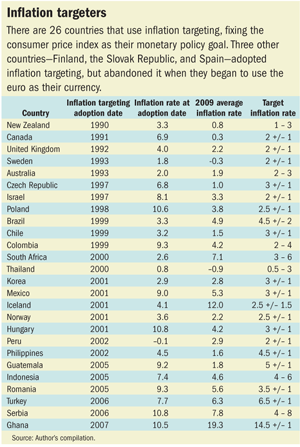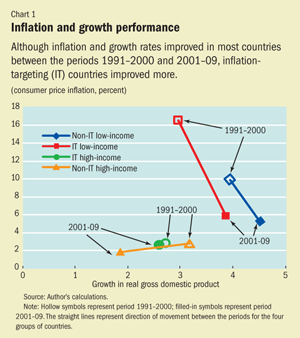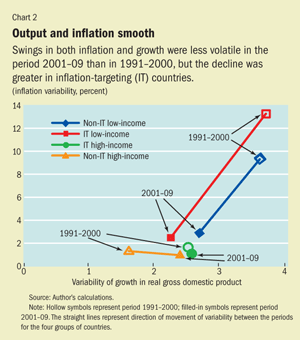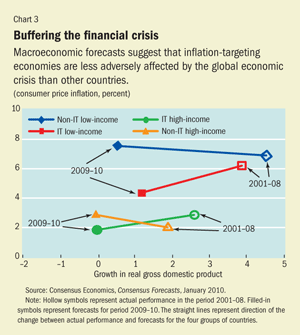Inflation Targeting Turns 20
Finance & Development, March 2010, Volume 47, Number 1
A growing number of countries are making a specific inflation rate the primary goal of monetary policy, with success
TWO decades ago, New Zealand adopted a new approach to monetary policy, based on achieving a specific target for inflation. What made this approach new was the explicit public commitment to controlling inflation as the primary policy objective and the emphasis on policy transparency and accountability.
Today 26 countries use inflation targeting, about half of them emerging market or low-income economies (see table). Moreover, a number of central banks in more advanced economies—including the European Central Bank, the U.S. Federal Reserve, the Bank of Japan, and the Swiss National Bank—have adopted many of the main elements of inflation targeting, and several others are in the process of moving toward it.
This article examines how inflation targeters have performed over the past 20 years—including during the commodity price shocks of 2006–08 and the global financial crisis that began in 2007. The article also highlights some especially important issues inflation targeters are likely to face in the next few years.
The inflation-targeting framework
From the outset, inflation-targeting frameworks have included four main elements (Mishkin, 2004; and Heenan, Peter, and Roger, 2006):
- an explicit central bank mandate to pursue price stability as the primary objective of monetary policy and a high degree of operational autonomy;
- explicit quantitative targets for inflation;
- central bank accountability for performance in achieving the inflation objective, mainly through high-transparency requirements for policy strategy and implementation; and
- a policy approach based on a forward-looking assessment of inflation pressures, taking into account a wide array of information.
These elements reflect both theory and experience that suggest central banks cannot consistently pursue and achieve multiple goals, such as low inflation and low unemployment, with only one basic instrument—the policy interest rate (for example, the federal funds rate in the United States or the bank rate in the United Kingdom). These elements also recognize that over the long term monetary policy can influence nominal but not real (inflation-adjusted) variables; high inflation harms growth and the equitable distribution of income; and expectations and credibility significantly influence the effectiveness of monetary policy.

With experience, and as the inflation-targeting framework has been adopted by emerging market economies, it has tended to evolve in two particularly important respects. First, there has been a progressive increase in policy transparency and communication as the key means of providing public accountability, which underpins the operational independence of central banks and helps anchor inflation expectations. The main ways central banks communicate their targets include inflation or monetary policy reports two to four times a year, public statements following policy meetings, and, sometimes, publication of the minutes of policymaking meetings. Senior central bank officials also testify before legislatures. In general, central banks have become increasingly active in a much broader range of public communication activities than in the past.
Second, central banks have generally pursued a flexible form of inflation targeting. Rather than focusing on achieving the inflation target at all times, the approach has emphasized achieving the target over the medium term—typically over a two- to three-year horizon. This allows policy to address other objectives—notably, smoothing output—over the short term. The central bank’s ability to be flexible, however, depends on keeping medium-term inflation expectations well anchored. And this depends, at least in part, on its track record in keeping inflation under control.
What about the alternatives?
A natural question is whether macroeconomic performance under inflation targeting has been as good as or better than under alternative policy approaches, such as targeting money growth, exchange rate pegs, or “eclectic” frameworks with multiple objectives. Because it is not possible to compare directly one country’s performance under two different policy regimes over the same period, comparisons have to be made between similar countries with different approaches.

Charts 1 and 2 compare inflation and output performance in inflation-targeting countries before and after they adopted inflation targeting with non-inflation-targeting countries over the same period. For inflation-targeting countries, the median inflation targeting adoption date was the beginning of 2001, so the comparison periods for non-inflation-targeting countries are set at 1991–2000 and 2001–09.
The evidence shows the following:
- Both inflation-targeting and non-inflation-targeting low-income economies experienced major reductions in inflation rates and improvements in average growth rates. Although the non-inflation-targeting countries continued to have lower inflation and higher growth than the inflation-targeting countries, those that adopted inflation targeting saw larger improvements in performance.

- Both inflation-targeting and non-inflation-targeting low-income economies also experienced large reductions in the volatility of inflation and output, with the countries that adopted inflation targeting registering bigger declines, especially in inflation volatility.
- Among high-income economies, inflation-targeting countries showed little change in performance, on average, between the two periods, whereas the non-inflation-targeting countries typically experienced a decline in growth. Similarly, inflation-targeting countries saw little change in output or inflation volatility between the two periods, but the non-inflation-targeting countries experienced greater output volatility.
Of course, adoption of inflation targeting may not fully explain the improvement in relative performance, since many countries adopting inflation targeting did so as part of broader structural and policy reforms. Nonetheless, more detailed studies also generally suggest that when otherwise similar emerging market economies are compared over the same time periods, key economic macroeconomic variables such as inflation and output performed better in countries that adopted inflation targeting compared with those that did not. For example, a study in the IMF’s September 2005 World Economic Outlook found adoption of inflation targeting to be associated with a 4.8 percentage point reduction in average inflation relative to other monetary policy regimes between 1990 and 2004. Inflation targeting was also associated with a 3.6 percentage point reduction in the variability of inflation relative to other strategies.
The resilience of inflation targeting
Of particular relevance, in the wake of the global commodity price spikes and financial shocks of the past three years, is whether inflation targeting is more resilient to shocks than are other policy frameworks. Throughout most of the period since inflation targeting was widely adopted, global macroeconomic conditions were benign compared with earlier periods. As a result, there was limited evidence that the inflation-targeting approach could absorb major shocks.
Inflation-targeting countries appear to have done better than others in minimizing the inflationary impact of the 2007 surge in commodity prices (Habermeier and others, 2009). That price shock led to a rise in inflation and declines in growth in most countries between 2006 and 2008. Among low-income economies, however, non-inflation-targeting countries experienced bigger increases in inflation than inflation-targeting countries, although their gross domestic product growth rates fell by similar amounts. Among high-income economies, inflation-targeting countries had a smaller growth decline than non-inflation-targeting countries and slightly less of an increase in inflation.
These results are consistent with the notion that inflation expectations are better anchored in countries that adopt inflation targeting and that authorities in those countries place a greater emphasis on keeping inflation from surging. But more detailed analysis will be needed to disentangle these effects from other influences on growth and inflation before any solid conclusions can be reached.
The global financial crisis that began in mid-2007 is still unfolding, so it is premature to judge whether inflation targeters have coped better than others with the worst global economic and financial downturn since the Great Depression. To be sure, several inflation-targeting countries have been among the hardest hit by the crisis, and some have entered into IMF-supported programs—including Hungary, Iceland, Romania, and Serbia. However, it is not clear that inflation targeting made these countries more susceptible to crises or that their downturns are more severe than in comparable countries with other policy approaches.

Macroeconomic forecasts suggest that inflation-targeting economies may be less adversely affected by the financial crisis (see Chart 3). According to Consensus Forecasts (Consensus Economics) in January 2010, average growth for all countries during 2009–10 is expected to fall well below the typical growth experienced during 2001–08. Among emerging market economies, however, non-inflation-targeting countries are generally expected to experience a larger decline than inflation-targeting countries in growth relative to precrisis averages. Among the high-income economies, the opposite is expected, with a bigger decline in growth among inflation-targeting than non-inflation-targeting countries. All inflation-targeting countries are expected to experience a decline in inflation. By contrast, inflation is expected to rise above precrisis levels in non-inflation-targeting countries.
The future of inflation targeting
The evidence indicates that inflation targeting has worked well in a broad range of countries and circumstances. In this context, the concerns expressed by several major central banks about a recent proposal by IMF Chief Economist Olivier Blanchard to raise inflation targets, as a way to give central banks more room to lower interest rates in severe downturns, suggest that key features of inflation targeting will remain intact. But the framework is bound to evolve as lessons are drawn from experience with inflation targeting, particularly as it is adapted to the needs of developing countries. Two issues stand out in particular.
- For many open economies that have adopted or are considering adopting inflation targeting, there is debate over the appropriate role of the exchange rate in an inflation-targeting framework.
- For all central banks, including inflation targeters, there is the question of how to reconcile their monetary policy responsibilities and objectives with their responsibility to promote and maintain the stability of the financial system.
The conventional wisdom has been that inflation-targeting central banks should react to exchange rate movements only insofar as they affect the outlook for inflation and output—depreciation of the currency may, for example, make exports cheaper, stimulating output, but at the same time exacerbate inflation—rather than systematically dampening exchange rate changes. More recent analysis, however, suggests that systematic leaning against exchange rate movements may be warranted in some circumstances. For example, in economies with high foreign currency debt, exchange rate movements will have strong effects on debtors’ financial balance sheet positions. So dampening exchange rate changes may help stabilize output and inflation (Morón and Winkelried, 2005; and Roger, Restrepo, and Garcia, 2009). The challenge for policymakers is to ensure that the exchange rate remains subordinate to the inflation objective and that dampening exchange rate movements does not undermine the credibility of the inflation-targeting framework.
The global financial crisis is also forcing a reassessment of the relationship between monetary policy and policies aimed at financial stability. In particular, a question arises analogous to that of the role of the exchange rate: should monetary policy respond directly to potential risks to financial stability—such as rapid increases in credit, property prices, or stock market values—or only insofar as these affect the outlook for inflation and growth?
At a minimum, the crisis has highlighted the need to pay greater attention to the interaction between the real economy of goods and services and the financial economy. The workhorse macroeconomic models central banks use in monetary policy analysis and forecasting lack substantial representation of the financial sector, the determination of key asset prices such as equity and property prices, and the interaction between the financial sector and household and corporate sector behavior. Nor do the models take account of interactions within the financial sector. Fixing such weaknesses will not be easy, but will be important if financial developments are to be better integrated into policy analysis and forecasting.
A key issue is whether central banks should use monetary policy, in addition to prudential policies, to react directly and systematically to financial stability indicators such as house prices. As with their response to exchange rate movements, this might be beneficial in some circumstances but not others and, by adding to the central bank’s objectives, could undermine the credibility of their commitment to the inflation target. Research is needed in this area, including determining the appropriate financial indicators to take into account and how the central bank should respond to them.
Another possibility is to extend the inflation-targeting horizon to take into account the longer-term inflation risks associated with asset price cycles (Borio and Lowe, 2002). An advantage of this approach is that it would be less mechanical than responding directly to asset prices or other financial stability indicators. Still, there are practical challenges. In particular, a lengthening of the forecast horizon would also require improving central banks’ medium- to long-term forecasting capabilities. In addition, there would be issues to sort out in terms of the appropriate timing of actions to counter development of asset price bubbles (Bean, 2004). Stronger policy communication would also be needed to ensure continued credibility of the central bank’s long-term commitment to low and stable inflation.
References
Bean, Charles, 2004, “Asset Prices, Financial Instability, and Monetary Policy,” American Economic Review, Vol. 94, No. 2, pp. 14–18.
Borio, Claudio, and Philip Lowe, 2002, “Asset Prices, Financial and Monetary Stability: Exploring the Nexus,” BIS Working Paper 114 (Basel: Bank for International Settlements).-
Consensus Economics, 2010, Consensus Forecasts (January).
Habermeier, Karl, and others, 2009, “Inflation Pressures and Monetary Policy Options in Emerging and Developing Countries: A Cross Regional Perspective,” IMF Working Paper 09/1 (Washington: International Monetary Fund).-
Heenan, Geoffrey, Marcel Peter, and Scott Roger, 2006, “Implementing Inflation Targeting: Institutional Arrangements, Target Design, and Communication,” IMF Working Paper 06/278 (Washington: International Monetary Fund).-
International Monetary Fund (IMF), 2005, World Economic Outlook (Washington, September).-
Mishkin, Frederic, 2004, “Can Inflation Targeting Work in Emerging Market Countries?” NBER Working Paper 10646 (Cambridge, Massachusetts: National Bureau of Economic Research).-
Morón, Eduardo, and Diego Winkelried, 2005, “Monetary Policy Rules for Financially Vulnerable Economies,” Journal of Development Economics, Vol. 76, No. 1, pp. 23–51.-
Roger, Scott, Jorge Restrepo, and Carlos Garcia, 2009, “Hybrid Inflation Targeting Regimes,” IMF Working Paper 09/234 (Washington: International Monetary Fund).


